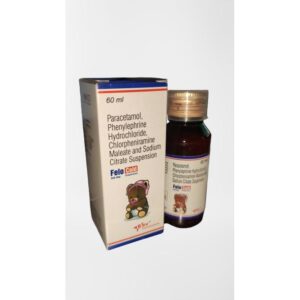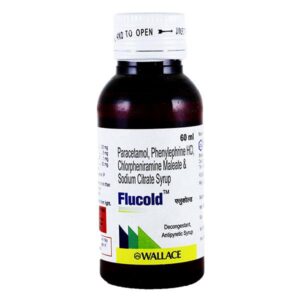CHLORPHENIRAMINE + PARACETAMOL (ACETAMENOPHEN) + PHENYLEPHRINE + SODIUM CITRATE
Chlorpheniramine: Chlorpheniramine is a medication classified as a first-generation antihistamine. It is commonly used to relieve symptoms associated with allergies, such as sneezing, itching, watery eyes, and runny nose. It can also be used to manage symptoms of the common cold, hay fever, hives, and other respiratory allergies.
The mechanism of action of chlorpheniramine involves blocking the action of histamine, a chemical substance released during an allergic reaction. By blocking histamine receptors, chlorpheniramine helps to alleviate allergy symptoms.
Chlorpheniramine is typically taken orally as a tablet or liquid, with or without food. The recommended dose for adults is usually 4 mg every 4-6 hours, not exceeding 24 mg in a 24-hour period. For children, the dosage is usually based on their age and weight, and should be determined by a healthcare professional.
While chlorpheniramine is generally well tolerated, it can cause certain side effects. The most common side effect is drowsiness, which can impair alertness and coordination. Other potential side effects may include dry mouth, blurred vision, constipation, difficulty urinating, and stomach upset. Less frequently, some individuals may experience dizziness, headache, nervousness, or irritability.
It is important to note that chlorpheniramine may interact with other medications, such as sedatives, tranquilizers, and certain antidepressants. It is advisable to consult a healthcare professional or pharmacist before starting chlorpheniramine or any other medication.
Paracetamol (acetamenophen): Paracetamol, also known as acetaminophen, is a commonly used over-the-counter medication for pain relief and reducing fever. It belongs to the class of medications called analgesics (pain relievers) and antipyretics (fever reducers).
Paracetamol works by inhibiting the production of chemicals called prostaglandins in the brain that are responsible for transmitting pain signals and inducing fever. By reducing the production of prostaglandins, paracetamol helps to alleviate pain and reduce fever.
Paracetamol is commonly used to relieve mild to moderate pain caused by conditions such as headache, toothache, muscle ache, common cold, osteoarthritis, and menstrual cramps. It can also be used to reduce fever associated with various infections.
The recommended dose of paracetamol for adults is usually 500 to 1000 milligrams, taken every 4 to 6 hours, with a maximum daily dose of 4 grams (4000 milligrams). However, it is important to carefully follow the dosing instructions on the packaging or as directed by a healthcare professional, as exceeding the maximum daily dose can lead to liver damage.
While paracetamol is generally considered safe when used as directed, it can cause side effects in some individuals. Common side effects may include nausea, stomach pain, or rash. In rare cases, an allergic reaction may occur, characterized by symptoms such as difficulty breathing, swelling of the face, lips, or throat, or hives.
It is important to note that paracetamol should not be taken with other medications that contain paracetamol, as exceeding the recommended maximum daily dose can increase the risk of liver damage.
As always, it is advisable to consult with a healthcare professional before starting any new medication to ensure it is appropriate for your specific condition and to discuss potential risks or interactions with other medications you may be taking.
Phenylephrine: Phenylephrine is a medication used primarily as a nasal decongestant and to treat hypotension (low blood pressure).
Mechanism of Action:
Phenylephrine works by constricting blood vessels, thereby reducing nasal congestion and increasing blood pressure. It belongs to a class of drugs called alpha-adrenergic agonists, which stimulate alpha-adrenergic receptors in blood vessels, leading to their constriction.
Use:
1. Nasal Congestion: Phenylephrine is commonly used to relieve nasal congestion caused by the common cold, allergies, or sinus infections. It helps shrink the swollen blood vessels in the nasal passages, making it easier to breathe.
2. Hypotension: Phenylephrine can be given intravenously to increase blood pressure in cases of acute hypotension, such as in shock or during certain medical procedures.
Dose:
The dose of phenylephrine varies depending on the form and strength of the medication. For nasal congestion relief, phenylephrine nasal sprays or drops are typically used with a recommended dose of 2-3 sprays or drops, repeated every 4 hours as needed. For hypotension, phenylephrine is administered intravenously in a healthcare setting, and the dose is determined by a healthcare professional.
Side Effects:
Common side effects of phenylephrine may include increased blood pressure, headache, dizziness, nervousness, restlessness, tremors, and difficulty sleeping. These side effects are usually mild and temporary. However, in some cases, phenylephrine can cause severe side effects such as chest pain, irregular heartbeat, severe headache, shortness of breath, or allergic reactions. It is important to seek medical attention if any of these serious side effects occur. Phenylephrine should be used with caution in people with certain medical conditions such as high blood pressure, heart disease, diabetes, or thyroid problems.
It’s important to note that phenylephrine is available both over-the-counter and by prescription, and different formulations and strengths may have varying directions and precautions. Therefore, it is advisable to carefully follow the instructions provided by the healthcare professional or read the product label when using phenylephrine.
Sodium Citrate: Sodium citrate is a medication commonly used as an anticoagulant and a urinary alkalinizing agent. It is available in oral solution, effervescent tablets, and injectable forms.
The primary use of sodium citrate is as an anticoagulant during blood transfusions to prevent clotting and thus maintain the stability of the blood. It works by binding to calcium ions, which are essential for the clotting cascade, and inhibiting their activity.
In urinary alkalinization, sodium citrate is prescribed to increase urine pH, which helps to prevent the formation of certain types of kidney stones. It achieves this by acting as a buffer and neutralizing excess acid in the urine.
The dose of sodium citrate depends on the specific indication being treated and the formulation used. For anticoagulant purposes during blood transfusions, it is typically administered intravenously at a dose of 4-8 millimoles per liter of blood. For urinary alkalinization, the usual dose is around 10-30 millimoles per day, divided into multiple doses, and taken orally.
Common side effects of sodium citrate include gastrointestinal disturbances such as diarrhea, nausea, and stomach pain. These effects are generally mild and subside on their own. However, prolonged use or overdose can lead to metabolic alkalosis, which is characterized by symptoms such as muscle twitching, confusion, and irregular heartbeat. It is important to consult a healthcare professional for advice on proper dosing and to monitor for any potential side effects.


